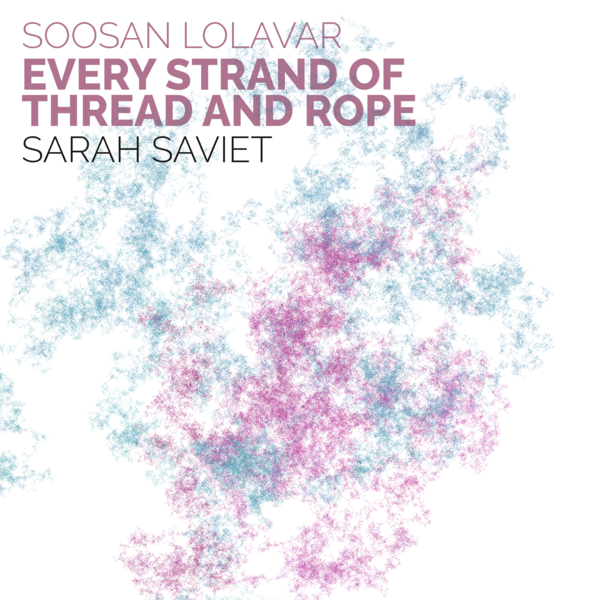
Soosan Lolavar
Every Strand of Thread and Rope
Sarah Saviet
atd18
binaural download only

‘Music in one place.’ Lolavar’s description of how she thinks of this series of pieces at first seems counterintuitive. The musicians involved are based in different cities (Lolavar in London, violinist Sarah Saviet in Berlin) and their creative process draws together practices from Iran and Europe. Yet this is music about shared experience; of creating a particular sound-world together.
Critical acclaim
The title Every Strand of Thread and Rope is not only a metaphor; it aptly draws attention to the physical properties of the instrument. Saviet’s violin is close mic’d, picking up every grain of the violin sound, all the friction of bow against string, all the harmonics, as if the sonority of the instrument has been magnified.
Recorded binaurally for the all that dust label – like many of their releases – Every Strand certainly recaptures the claustrophobic, close-up texture of the time in which it was born. As Saviet’s bow gasps and struggles across its compromised terrain, every click and pop of the strings is rendered in high resolution. Saviet’s playing captures with staggering control the full potential of every one of these sounds, but the recording can be challenging to listen to: a little too intimate, like seeing someone’s face pressed up too close to their Zoom screen. Or perhaps, somehow and more magically, one is pushing one’s own face past the screen itself and into the world of pixels beyond. For there is more to Lolavar’s extended piece than the pandemic anxiety from which it began.
Tracks
| Every Strand of Thread and Rope | ||
| 1 | i. Warp | 5:32 |
| 2 | ii. Undone | 6:19 |
| 3 | iii. Fibres | 8:00 |
| 4 | iv. Chainmail | 5:48 |
| TT | 25:38 |
Undone was composed in 2020 and commissioned by Sally Groves for the Riot Ensemble’s Zeitgeist project.
Liner notes
‘Music in one place.’ Soosan Lolavar’s description of how she thinks of this series of pieces at first seems counterintuitive. The musicians involved are based in different cities (Lolavar in London, violinist Sarah Saviet in Berlin) and their creative process draws together practices from Iran and Europe. Yet this is music about shared experience; of creating a particular sound-world together.
Tuning — or more accurately, detuning — was key to unlocking that sound-world. Lolavar devised her initial pitch materials on the santoor, a hammered dulcimer that is tuned to a particular mode; in other words, it cannot modulate midway through a piece. She sent her ideas to Saviet, who explored them on a violin tuned down a minor sixth. Such extreme scordatura radically changes the tension of the strings: pitch is the obvious change, but bow strokes also become unpredictable, and timbres throaty. Heard up close as a binaural recording the instrument sounds at once less and more like a violin.
Undone was composed first. The title came after the piece was finished and reflects and questions the feeling of being kept safe, in one place, during the 2020 lockdowns. Although it stays in the same mode, contrasting states emerge on different sets of pitches: one is marked ‘tense’ and is aggressive, full of grit and verve; the other is marked ‘cantabile’, its notes long and strident. The prominence of tremolando and glissandi nods to traditional santoor techniques, while the emphasis on limited pitch materials relates to Iranian classical music and its melodic focus on the interval of a tetrachord.
Lolavar and Saviet returned to the project in winter 2022, taking Undone as their starting point for three further pieces. Each uses the same mode and continues to embrace the normally unwanted and discarded sounds produced by the extreme detuning of the violin. In comparison to the declamatory nature of Undone, Warp is fairly open, the score indicating directions and shapes to guide the performer’s improvisation. Fibres is ‘meditative, light’, its whispered tremolo suggesting stillness and fragility.
By contrast, Chainmail is marked to be played ‘boldly, like a ritual’. The pitches are still drawn from Lolavar’s singular mode, but the piece incorporates figures and forms from the radif: specifically, dance rhythms for hammered dulcimer referred to as ‘chahar mezrab’. The first half uses rhythms from a mourning song; the second rhythms from a wedding march. The agency granted to the instrumentalist to make decisions in the previous movements seems overtaken by the repeated gestures. Yet neither composer nor performer has full control over the repetitions, for the detuned violin introduces unexpected glitches, harmonics and multiphonics. The physicality of playing, the effort of bow on string, comes to the fore. Freed from normal constraints, Every Strand of Thread and Rope grants entry to a beautiful sound-world which, as Saviet says, we ‘might like to stay in longer’.
Laura Tunbridge